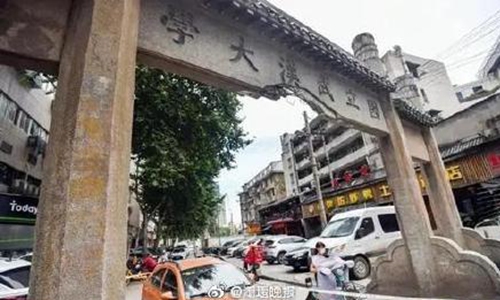Restoration begins on 83-year-old traditional Chinese archway at Wuhan University following accident
By Chen Xi Source:Global Times Published: 2020/6/7 17:33:40

Damaged Paifang of Wuhan University in Central China's Hubei Province Photo: Sina Weibo
Work to restore a decades-old paifang, a traditional Chinese commemorative archway, at Wuhan University in Central China's Hubei Province has begun. The archway was damaged on Saturday when a cement mixer collided into it. According to a statement issued on China's Twitter-like Sina Weibo by Wuhan University on Sunday, local police have tracked down the driver of the vehicle, who will be punished according to law."Companies and personnel involved in the incident will be punished according to law, and height-limiting poles around the archway will be installed to further strengthen protection of cultural relics," read the statement.
The paifang was first built in 1931, but the wooden structure was severely damaged after it was hit by a tornado. It was later rebuilt in 1934, and became a landmark entryway to Wuhan University. In 2001, the paifang was included in the fifth batch of National Key Cultural Relic Protection Units, according to reports.
The hashtag for the accident has earned 110 million views on Sina Weibo as of Sunday afternoon.
Some Chinese netizens suggested that the paifang be moved further inside the university's campus to avoid similar accidents from occurring.
However, Zhen Gang, an expert in cultural relic restoration at the Shaanxi Institute for the Preservation of Cultural Heritage, told the Global Times on Sunday that moving the paifang or other any cultural relic is not an ideal response. Rather improving comprehensive urban management and renovating the relic's surrounding environment are more suitable solutions.
"The position of each cultural relic is a witness to Chinese history. Moving them might be disrespectful to its history," he said.
Chen Leng, a professor at School of Archaeology and Museology in Peking University, echoed Zhen's opinion. However, he told the Global Times on Sunday that installing height-limiting poles is just a temporary measure, and a better long-term solution is to incorporate cultural heritage into the overall plan of the city.
He suggested designating some cultural blocks focused on various cultural heritages and their characteristics.
"This will not only protect the city's cultural heritage, but also further highlight and show the value of the cultural heritage in the city," he said, emphasizing that raising the awareness of local government and residents for cultural heritage's protection can avoid similar accidents.
It has been difficult to protect relics such as paifang built outside of campuses. For example, the inscriptions on two paifang built in 1930 at Sun Yat-sen University in South China's Guangdong Province were altered by the two schools that took over the campus after Sun Yat-sen University relocated. However, they were eventually restored to their original likeness, China news site The Paper reported on Sunday.
Posted in: RELATIONSHIPS,CULTURE & LEISURE